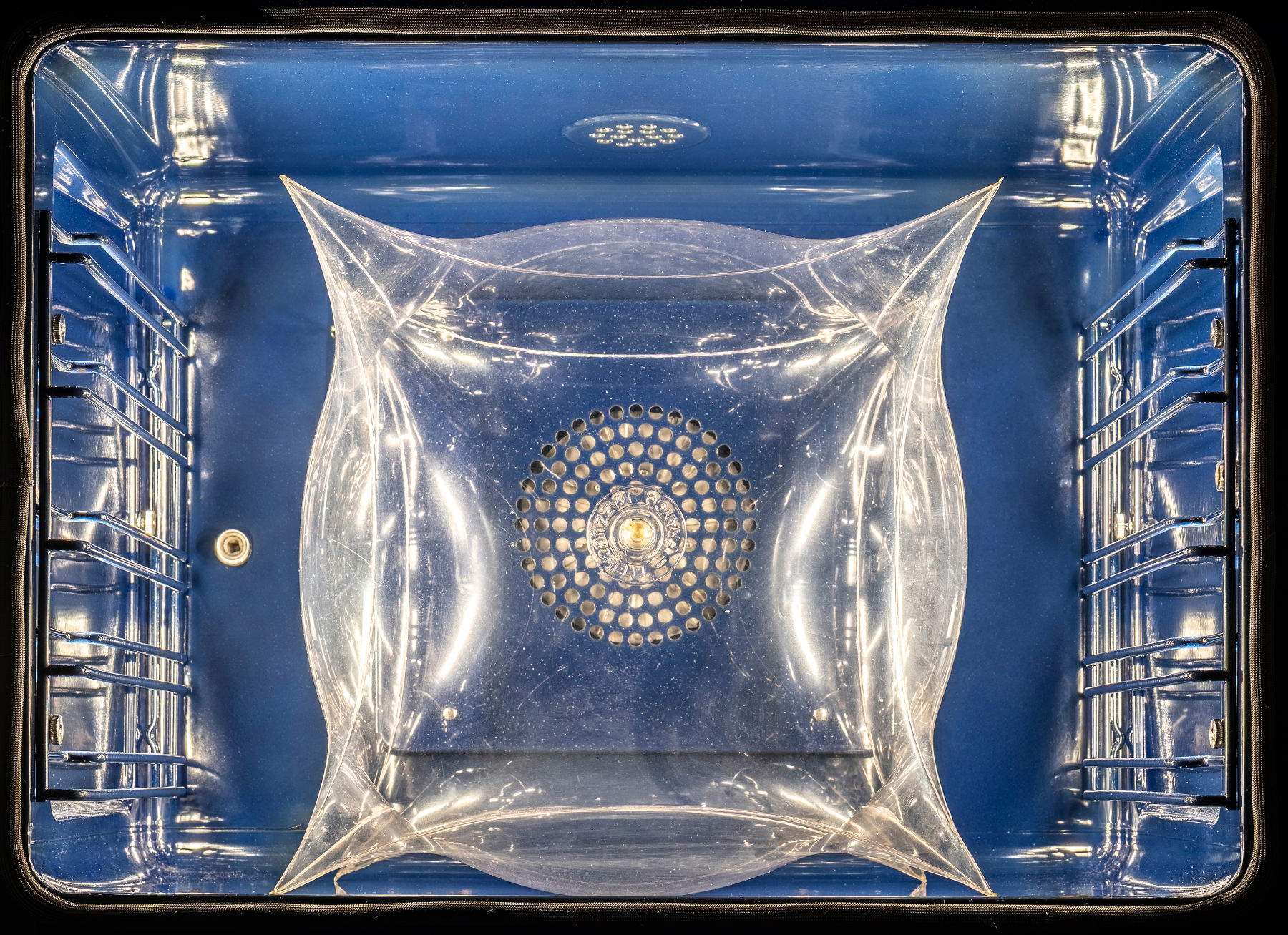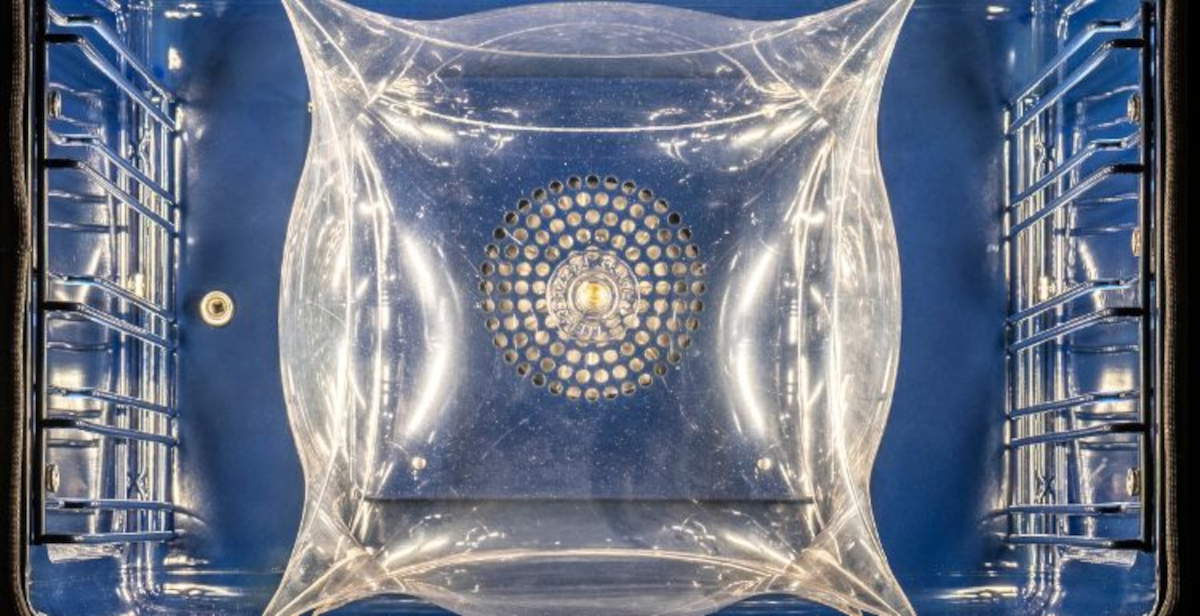On June 10, 2025, the historic Villa Carafa Belvedere, also known as Palazzo Belvedere and located in theVomero district ofNaples, will extraordinarily open its doors to the public to host the exhibition In-Natura by artistFrancoMazzucchelli (Milan, 1939). The initiative, curated by Sabino Maria Frassà, proposes an unprecedented dialogue between the inflatable art of the Milanese Mazzucchelli, seventeenth-century Baroque architecture and the design of the new Expressive oven produced by Gaggenau.
“Franco Mazzucchelli is known as the master of inflatables, but In-Natura reveals his most authentic essence: that is, that he has always been the tailor of the invisible,” says Sabino Maria Frassà. “Mazzucchelli forces us to radically rethink the concept of form. His art is pure movement, an action that gives body to the air, without ever indulging in decoration or rhetoric of weight. Just as in Luca Giordano’s paintings, through the myth of Niobe, there is a reflection on measure and the balance between greatness and awareness, so too Mazzucchelli reminds us, with poetic lightness, that life - like art - is but a continuous breath: fragile, impermanent, vital. Mazzucchelli’s artistic gesture, absolute yet intrinsically light, is powerfully intertwined with Aristotle’s thought that matter is power - possibility of being - and form is act - concrete realization of that being. Formless matter is not absence, but openness to transformation. As Aristotle writes in the Metaphysics(IX, 8, 1050a): ’ἡ μὲν ὕλη δύναμις, τὸ δὲ εἶδος ἐνέργεια’ - ’Matter is power, form is act.’ Matter exists as possibility, form as the fulfillment of that possibility. This exhibition reminds us that what is alive is not stable, but in becoming. Mazzucchelli’s art is an act of collective breath.”
“On the surface, in the Naples leg of the FORMAE project, the interaction between Maestro Mazzucchelli’s distinctive artistic language and the synthesis of technology and aesthetic research that belongs to Gaggenau seems to propose the juxtaposition of dissonant dimensions,” says Mistral Accorsi, Gaggenau Product & Brand Communication Manager. “On the contrary, the encounter between Expressive ovens and the evocative lightness of art installations-which, to quote Shakespeare, are made of the same substance as dreams-composes a symphony of harmonic contrasts. This dialogue between matter and vision invites us to reflect on the essence of creativity and human ingenuity, capable of transforming everyday matter into form, beauty and meaning.”
“What is art, if not the attempt to shape one’s thoughts and share them with others? Art, for me, has always been an exchange, even before a physical object. The artifact is only the beginning of a journey that opens to infinity, pushing beyond myself and beyond the present time,” adds Franco Mazzucchelli.
In-Natura represents the third stage of the FORMAE exhibition cycle, promoted by luxury design brand Gaggenau in collaboration with CRAMUM and Italy Sotheby’s International Realty. The project, under the artistic direction of Sabino Maria Frassà, aims to enhance some of Italy’s most relevant historic buildings through a path that explores the transformation of matter into form, thought and beauty. After the stages in Milan and Florence, Naples is the new venue chosen for the continuation of this exhibition project. The exhibition takes place in the rooms of the villa, some of which were frescoed by Luca Giordano, among the greatest exponents of Neapolitan Baroque painting. Mazzucchelli’s artistic intervention takes the form of a site-specific installation, designed to establish a dynamic interaction with the surrounding architectural environment. The works on display, all made of transparent materials, generate a change in the spatial perception of the visitor, who is invited to reconsider the environment as a living entity in continuous transformation. Through inflatable structures that unfold between decorated walls and period furnishings, the exhibition path induces a reflection on the relationship between presence and absence, form and emptiness, permanence and change. The exclusive adoption of transparency in materials accentuates the sense of impermanence and relativity: nothing is stable, every vision is subject to variation. The stated goal is to overcome the distinction between work and space, between object and environment, in favor of a fluid and interactive reading of form.
At the heart of the exhibition itinerary, the main hall hosts one of the exhibition’s central works: a totemic structure that houses Gaggenau’s new Expressive oven. The minimal lines of the appliance, inspired by the formal sobriety of Baussian thought, contain within them the Cubosphere, one of Mazzucchelli’s best-known symbolic sculptures. It is a geometric form that visually synthesizes the tension between order and irregularity, an attempt to reconcile the roundness of the circle with the rigidity of the cube, evoking concepts of perfection and imperfection. In this framework, the kiln is not just a container, but a kind of symbolic still, in which the interaction between art, technology and design produces a new idea of matter. The title of the exhibition, In-Nature, recalls the ephemeral and at the same time processual character of Mazzucchelli’s work. His inflatable works, already known for urban interventions such as the series Abbandoni, reflect on the instability of form and the need for continuous adaptation.

Franco Mazzucchelli, born in Milan on January 24, 1939, graduated in painting in 1963 and in sculpture in 1966 from the Brera Academy of Fine Arts. His career is distinguished by participation in major events, including the 1976 and 2024 Venice Biennale and the 11th Rome Quadrennial in 1986. In 2022 he received the Alfredo d’Andrade Lifetime Achievement Award. Beginning in the 1960s, Mazzucchelli began pioneering research into the use of plastic materials, shaping large inflatable structures designed to be abandoned in public settings. With these interventions, conceived as acts of relationship between art, urban landscape and nature, the artist redefines the relationship between work and viewer, promoting a participatory and shared art. The photographic and video documentation of his works emphasizes their dynamic integration with space. Since the second half of the 1970s, his PVC inflatable sculptures have evolved into polyethylene installations, traversable by the public and capable of transforming them into an active part of the work.
In the 1990s, his practice extended toward new aesthetic and social trajectories with the REC and A.ON.A. cycles, culminating in the Bieca Decorazione (BD) project, which investigates the fine line between visual seduction and provocation. To this day, Mazzucchelli continues to experiment, driven by a desire to investigate new modes of perception through his signature elements: plastic and air. Recent solo exhibitions born from the collaboration with CRAMUM and curator Sabino Maria Frassà include Non abbandonarmi! at Studio Museo Francesco Messina (Milan, 2015), Non ti abbandonerò mai at Museo del Novecento (Milan, 2018) and BI-FACE at Gaggenau Milano (2019). Also of note are installations such as Salvami Andata-Ritorno for Design Week 2018 and Quadreria 2050 at the Macro Museum in Rome. In parallel to his artistic activity, Mazzucchelli has taught Sculpture Techniques and coordinated the Department of Multimedia Visual Communication at the Brera Academy, contributing to the training of numerous young artists.
 |
| Franco Mazzucchelli and Gaggenau in Naples: inflatable art and design in the baroque Villa Carafa |
Warning: the translation into English of the original Italian article was created using automatic tools. We undertake to review all articles, but we do not guarantee the total absence of inaccuracies in the translation due to the program. You can find the original by clicking on the ITA button. If you find any mistake,please contact us.